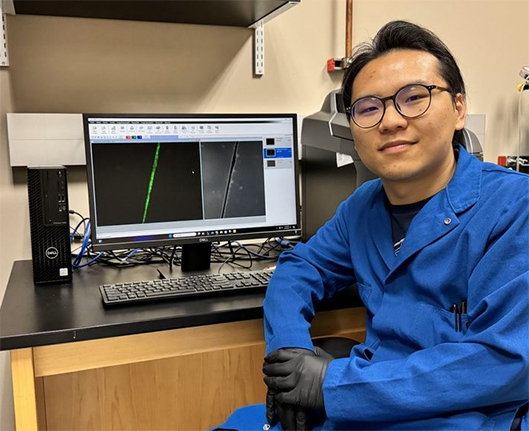Researchers Develop Biomolecule Assembly Method for Photoconductive Devices

Sept. 5, 2024 - UC Irvine researchers have developed a new method of assembling nanometer-thin biomolecules that can generate light-triggered electrical currents. Their new Lego-like approach for material design could pave the way for more efficient nanoscale device technologies with applications in harvesting energy and stimulating cells.
“We gained a fundamental understanding of how electroactive biomolecules and atomically precise inorganic surfaces interact, and together we made devices that can use lower power, visible light sources to generate localized currents,” said co-lead investigator Herdeline Ardoña, assistant professor of chemical and biomolecular engineering.
Published in Science Advances, the research was co-led by Ardoña and Maxx Arguilla, assistant professor of chemistry, while the first author, Zefan Yao is a postdoctoral fellow in the Ardoña lab and co-advised by Arguilla.
The new approach could lead to improved designs of medical devices such as neural or cardiac electrodes, which record and stimulate activity of the nervous or cardiac system. It could also enhance energy harvesting devices such as solar cells. These devices, which are all commonly in use now, are wired systems that rely on inorganic materials. The new light-sensitive assembly method - akin to stacking Lego™ pieces - could enable visible light-powered devices, increasing accessibility and modularity.
“We used a one-dimensional (1D) inorganic crystal to direct the ordering of electroactive biomolecules on device surfaces,” said Ardoña. The researchers matched the molecular stacking dimension of the peptide-based organic components to that of the dimensionality and atomic-scale crystalline ordering of the 1D inorganic crystals, and that led to a hybrid photoconductive interface.
Ardoña says that while previous studies have utilized nano- or micropatterned substrates to guide assembly formation, this work takes advantage of the well-defined atomic ordering of 1D inorganic crystals and essentially pushes their precision synthetic control to approach the sub-nanometer regime, breaking the norm in templating approaches for organic assemblies.
– Lori Brandt
